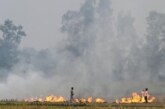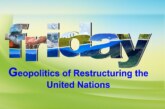
Dr. Arvind Kumar*
What if the Northeast of India was not the periphery, but the pulse beating at the edge of India’s emergence? Imagine a place where mountains are not barriers, but connectors; where rivers do not divide, but deliver promise. What happens when isolation becomes opportunity, when remoteness gives birth to resilience? These are not just rhetorical questions they are the lived realities unfolding in Northeast region of India personally witnessed by me. The impact was evident, the states’ economies doubled, migration slowed, an entrepreneurial culture took root, alternative livelihoods were created, and environmental sustainability formed the foundation of this overall development. For years, many spoke of the Northeast in terms of distance; distance from the capital, markets, infrastructure, and opportunity. Today, change is rewriting those narratives. According to the latest NER SDG Index, 103 out of 121 districts are now “Front Runners.” Disparities remain, but the momentum is undeniable.
Hon’ble Prime Minister Shri Narendra Modi recently called the region “a geostrategic asset, not a liability,” while US Ambassador Eric Garcetti reminded that “progress in the Northeast is not possible without peace.” These metaphors and metrics matter because they shift how we see the region, not as a borderland of disadvantage, but as a frontier of possibility. This transformation showcases the Northeast’s potential to serve as a global model of sustainable growth, balancing economic development with ecological sustainability. The decline in insurgency and extremism, facilitated by peace accords and security initiatives, has created a virtuous cycle: development has promoted peace, and peace has enabled further development.
A significant highlight of this progress was the inauguration of the Bairabi–Sairang railway line in Mizoram by Prime Minister Narendra Modi. The line connects Aizawl to the national railway network for the first time since independence. Beyond passenger convenience, the line will also improve freight movement, open new markets for local produce like bamboo and horticulture, and provide a strong boost to tourism and employment. This firmly places Mizoram on the map of India’s development story
It was in this spirit that the High-Level Policy Dialogue on “From Periphery to Mainstream: Northeast India’s Development Pathways”, convened by the India Water Foundation as an official side event of the 60th Session of the UN Human Rights Council at Palais des Nations, Geneva, sought to reflect on how far the region has come, and where it must go next.
A panacea to National Integration
The infrastructure transformation in Northeast India is one of modern India’s most remarkable development stories; over 11,000 km of highways built, railway networks expanded, and airports doubled within a decade. The Sela Tunnel in Arunachal Pradesh and the Bhupen Hazarika Bridge in Assam are not merely feats of engineering, they are symbols of unity, bridging divides that were once geographic and social. Yet, as I emphasized in my address at the Dialogue, connectivity here has never been about asphalt and steel alone. It is about “transformation through transportation.” Linking the Northeast with the rest of India and with its Himalayan and ASEAN neighbours has opened markets, created livelihoods, and reinforced political integration. But true success lies in balancing hard infrastructure with soft, people-centric approaches. Peace accords, which have reduced violent incidents by 70 percent and civilian casualties by nearly 90 percent, remind us that without social cohesion, no road or bridge can carry development forward.
The Dialogue underscored how the Northeast has woven ecological stewardship into its growth model. Sikkim, the world’s first organic state, and the bamboo economy, accounting for nearly half of India’s production, show that sustainability is not an afterthought but the very strategy. Ms. Mikiko Tanaka, Director & Head, SSWA, UN ESCAP stressed that regional trade doubled over the past decade from USD 11 billion to USD 23 billion, yet benefits will remain shallow unless inclusive trade practices uplift women, smallholders, and border communities. Dr. Pema Gyamtsho, Director General of ICIMOD, reminded us that while India’s average forest cover is 25%, the Northeast boasts nearly 67%. From Meghalaya’s innovative Payment for Ecosystem Services program to ICIMOD’s award-winning Flood Early Warning System in Assam, communities are showing that livelihoods and conservation can reinforce one another. As he put it, the region is not merely catching up, but “showing pathways for inclusive, ecosystem-based development.”
Similarly, Prof. Eddy Moors, Rector, IHE Delft highlighted the paradox of abundance: despite receiving over 10 meters of rainfall annually in some areas, many communities still face water stress. His call to treat water as a connector linking health, energy, agriculture, and rights echoes deeply with my own conviction that water is the fulcrum of sustainable development in the region.
Beyond infrastructure and ecosystems, the Dialogue repeatedly circled back to people. Mr. Vinod Mishra of UNOPS pointed to a leap in SDG performance front-runner districts rising from 62% in 2021–22 to 85% in 2023–24. Gains in poverty reduction, health, and education are evident, but climate action and inequality remain unfinished tasks.
Mr. Satheesh Kumar Damodaran urged India to see the Northeast as a playbook of cooperative federalism, while Moderator Ms. Shweta Tyagi reminded us that the real power lies in skilling youth, empowering women entrepreneurs, and ensuring dignity through local trade such as border haats.
Way Forward
Having worked in the Northeast for over fifteen years, I believe the next phase of its transformation must look beyond infrastructure gains to embrace a holistic agenda. The region needs to generate quality jobs through value-added industries, organic farming, agro-processing, renewable energy, and creative sectors so that growth directly benefits its educated youth. Skilling and entrepreneurship must move in tandem, with a strong emphasis on digital literacy, green technologies, and women-led enterprises. Climate resilience, too, has to be mainstreamed into every sector through climate-smart agriculture, disaster-resilient infrastructure, and ecosystem-based adaptation in fragile mountain zones. Strengthening cooperative federalism and deepening cross-border partnerships with Bangladesh, Bhutan, and Nepal will be vital, turning geographical location into a strategic advantage for trade, knowledge exchange, and shared ecosystem management.
The Dialogue in Geneva reaffirmed that Northeast India’s rise is about more than roads or grids, it is about peace, ecological stewardship, and community empowerment. Encouragingly, the international community is already responding: the World Bank’s $470 million transmission project and ADB’s investments in connectivity and climate adaptation reflect strong global confidence. Looking ahead, the Northeast has the opportunity to set new global benchmarks for how fragile yet diverse regions can thrive sustainably. Its story offers not just a vision for India’s future, but also a blueprint for the Global South, proof that resilience is strongest when economic dynamism, social inclusion, and environmental sustainability move forward together.
*Editor, Focus Global Reporter





